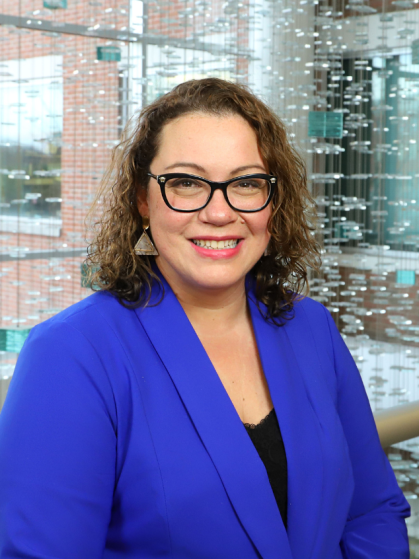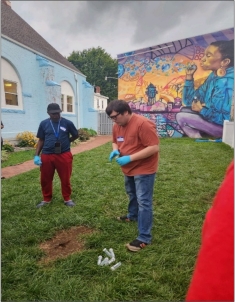As we honor National Hispanic Heritage Month, which is observed from September 15 to October 15, we celebrate Hispanic Americans’ histories, cultures, and contributions.
Dr. Zorimar Rivera-Núñez is an assistant professor in the Rutgers School of Public Health’s Department of Biostatistics and Epidemiology and a proud Latina. Her journey - from navigating language barriers to leading groundbreaking research on environmental exposures and maternal health - is a testament to resilience, perseverance, and the power of heritage.
We sat down with Dr. Rivera-Núñez to discuss how her Puerto Rican roots influence her work.
How has your heritage influenced your journey in public health, particularly in environmental health sciences?
My Hispanic heritage influences every aspect of my life.

After receiving my undergraduate degree, I moved from Puerto Rico to Washington, D.C., for a job that would help me get into graduate school and receive a fellowship. Although at the time I did not speak English fluently, my lab experience and analytical and statistical skills helped me obtain a National Cancer Institute fellowship. In graduate school, I had many professors with no empathy for my struggles and little patience for understanding that language was a problem, not a barrier. However, others supported me, offered resources, and, most importantly, listened. For them, I’ll forever be grateful.
The language barrier, being away from family, and even the weather were real challenges during that time. Today, all those hurdles have encouraged me to participate in inclusion initiatives and have a voice in the room when, most of the time, I’m the only Latina faculty member.
Currently, I’m involved in environmental health research and serve on scientific committees dedicated to research for the Puerto Rican population. Here in New Jersey, I conduct participatory research on issues such as COVID-19 and lead exposure, which directly impact Hispanic people and populations.
Your research often explores the intersection of environmental exposures and maternal and child health. How do you think these issues impact Hispanic communities, and what has your research revealed about these disparities?
Environmental exposures disproportionately impact Hispanic, Black, and Brown communities.
There are many examples of this. In my native Puerto Rico, chemicals associated with personal care products, such as phthalates and parabens, tend to be higher in pregnant women compared to women of reproductive age in the general U.S. population. Phthalates and parabens are endocrine-disrupting chemicals that interfere with hormone systems and can impact mothers and their fetuses during pregnancy. Our work suggests that this may be due to cultural differences in the use of personal care products since there is a strong culture of beauty and beauty practices that impacts Latina women.
The beauty industry's marketing strategies also play a role. Some companies specifically target Black and Brown consumers with their marketing campaigns, possibly resulting in higher exposure to health-harming chemicals.
You've done significant work on how environmental factors affect early life development. What are some of the key findings you've uncovered in this area?
A lot of my research focuses on how environmental exposures impact hormone systems during pregnancy. Hormones such as estrogens and androgens are critical for fetal growth and development. We have documented that environmental exposures, including to multiple metals, per- and polyfluoroalkyl substances (commonly known as PFAS), and mycotoxin zearalenone, alter hormone concentrations during pregnancy. Additionally, my team’s research was the first to show that neighborhood stressors, such as violence and vacant lots, negatively impact hormone concentrations during pregnancy.
In another area of study, my team and I have documented changes in drinking water disinfection treatments and the impact of drinking water disinfection by-products (DBPs) on birth outcomes. In the U.S., we use chlorination to eliminate harmful pathogens from drinking water. When chlorine mixes with organic matter naturally occurring in water at treatment facilities, it produces a series of chemicals known as DBPs. DBPs have been associated with lower birth weight, a higher risk of stillbirth, and various birth defects.
What ongoing or future projects are you particularly excited about, and what impact do you hope they will have on public health?
Since arriving at Rutgers, I have been studying zearalenone, a mycotoxin found in grains, meat, and dairy products. Zearalenone has estrogenic characteristics, which can potentially affect maternal and fetal health. Importantly, zearalenone exposure is predicted to increase due to changes in temperatures and humidity associated with climate change. As such, the presence of mycotoxins in our food and their impact on human health is an emergent public health issue.
I’m also very excited about new collaborations with communities in New Jersey, which for decades have been overburdened by lead-contaminated water, soil, and paint. Lead is a neurotoxin, and early-life exposure to it has profound implications for child health, particularly neurodevelopment. Together with our community partners, we are investigating strategies to reduce lead exposure.
How do you engage with community partners or policymakers to ensure that your research influences real-world health policies or practices?
This is such an important question. By working together with the communities we serve, we ensure that they know our interests and - most importantly - our research reflects their needs. Our Rutgers National Institute of Environmental Health Sciences Center for Environmental Exposures Disease allows us to collaborate with statewide environmental, health, and public policy organizations to address environmental stressors. For example, we collaborate with community groups from Trenton and Newark to help them move forward with their goals of reducing lead exposure, providing environmental health education, and capacitating their members to serve their community better.
What advice would you give to students or early-career researchers who are interested in environmental health sciences and public health?
Environmental health sciences are at the core of public health. Access to clean water and air, playgrounds, healthy foods, and cleaner personal and consumer products are essential to healthy communities.
My advice is to let the needs of your community guide your work. Invite community members to be active voices in your research process. If you are in the laboratory, explore different ways your research can contribute to reducing current gaps in health equity. Be sure to share and explain your research to others so they can use it to positively change their health.

I work with wonderful students connecting wet lab science with community work. Sean Stratton, a doctoral student at the Rutgers School of Public Health, has developed analytical protocols to determine lead sources in East Trenton, New Jersey, which is a community overburdened by lead exposure. As part of his National Institute of Environmental Health Sciences fellowship, he trains community scientists to conduct soil sampling. Additionally, Sean works with Megan Hansel, who is also a doctoral student at the school, to examine neighborhood stressors, social vulnerability, and toxic metal exposure during pregnancy. Megan has been leading our neighborhood stressor work in relation to maternal health in the last few years.


